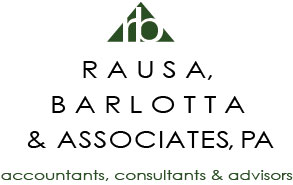Recent Developments in the Tax Cuts and Jobs Act
The following is a summary of important tax developments that have occurred in July, August, and September that may affect you, your family, your investments, and your livelihood. Please call us for more information about any of these developments and what steps you should implement to take advantage of favorable developments and to minimize the impact of those that are unfavorable.
IRS shoots down states’ SALT limitation workaround. For 2018 through 2025, the Tax Cuts and Jobs Act (TCJA) limits an individual taxpayer’s annual SALT (state and local tax) deductions to a maximum of $10,000, with no carryover for taxes paid in excess of that amount. (The SALT deduction limit doesn’t apply to property taxes paid by a trade or business or in connection with the production of income.) As a result of this change, many taxpayers will not get a full federal income tax deduction for their payments of state and local taxes. Following the TCJA’s passage, some high-tax states implemented workarounds to mitigate the effect of the SALT deduction limit for their residents. One method used was the establishment of charitable funds to which taxpayers can contribute and receive a tax credit in exchange. The IRS has issued proposed regulations, which would apply to contributions after Aug. 27, 2018, that effectively kill this workaround. The regulations would provide that a taxpayer who makes payments to or transfers property to an entity eligible to receive tax deductible contributions must reduce his or her charitable deduction by the amount of any state or local tax credit the taxpayer receives or expects to receive.
IRS also clarified that the proposed regulation crackdown on the SALT limitation workaround doesn’t apply to businesses. In other words, a business generally can deduct a payment to a charitable or governmental entity if the payment is made with a business purpose.
IRS clarifies who is a qualifying relative for family credit purposes.Under the TCJA, effective for tax years beginning after Dec. 31, 2017 and before Jan. 1, 2026, you can’t claim a dependency exemption for dependents, including qualifying relatives, but you may be eligible for a $2,000 credit for each qualifying child and a $500 credit (called the “family credit”) for each qualifying non-child dependent, including qualifying relatives. One of the conditions for being a qualifying relative is that the person’s gross income for the year can’t be more than the exemption amount. That condition remains the same in the Tax Code, but the exemption amount has been reduced to zero because the dependency exemption has has been eliminated. The IRS has clarified that the gross income limit for a qualifying relative for tax credit purposes (as well as for other purposes, such as head-of-household status), is determined by reference to what the exemption amount would have been if it hadn’t been reduced to zero by the TCJA. Thus, after 2017 and before 2026, the gross income limit is $4,150, adjusted for inflation after 2018.
IRS explains 20% deduction for qualified business income.The IRS has issued regulations on the new 20% deduction for qualified business income (QBI) created by the TCJA, also known as the pass-through deduction. Here’s a summary of the basic rules:
For tax years beginning after Dec. 31, 2017, taxpayers other than corporations may be entitled to a deduction of up to 20% of their qualified business income (QBI) from a domestic business operated as a sole proprietorship, or through a partnership, S corporation, trust or estate. This deduction can be taken in addition to the standard or itemized deductions.
In general, the deduction is equal to the lesser of: (A) 20% of QBI plus 20% of qualified real estate investment trust (REIT) dividends and qualified publicly traded partnership (PTP) income, or (B) 20% of taxable income minus net capital gains.
QBI generally is the net amount of qualified items of income, gain, deduction, and loss, from any qualified trade or business. But QBI doesn’t include capital gains and losses, certain dividends and interest income, reasonable compensation paid to the taxpayer by any qualified trade or business for services rendered for that trade or business, and any guaranteed payment to a partner for services to the business.
Generally, the deduction for QBI can’t be more than the greater of: (a) 50% of the W-2 wages from the qualified trade or business; or (b) 25% of the W-2 wages from the qualified trade or business plus 2.5% of the unadjusted basis of certain tangible, depreciable property held and used by the business during the year for production of QBI. But this limit on the deduction for QBI doesn’t apply to taxpayers with taxable income below a threshold amount ($315,000 for married individuals filing jointly, $157,500 for other individuals, indexed for inflation after 2018), with a phase-in for taxable income over this amount.
A qualified trade or business doesn’t include performing services as an employee. Additionally, a qualified trade or business doesn’t include a trade or business involving the performance of services in the fields of health, law, accounting, actuarial science, performing arts, consulting, athletics, financial services, investing and investment management, trading, dealing in certain assets or any trade or business where the principal asset is the reputation or skill of one or more of its employees. This exception only applies if a taxpayer’s taxable income exceeds $315,000 for a married couple filing a joint return, or $157,500 for all other taxpayers; the benefit of the deduction is phased out for taxable income over this amount.
The IRS’s new regulations explaining the 20% deduction for QBI are highly detailed and complex. A sampling of the important guidance contained in the guidance follows:
- Partnership guaranteed payments are not considered attributable to a trade or business and thus do not constitute QBI.
- To the extent that any previously disallowed losses or deductions are allowed in the tax year, they are treated as items attributable to the trade or business for that tax year. But this rule doesn’t apply for losses or deductions that were disallowed for tax years beginning before Jan. 1, 2018; they are not taken into account for purposes of computing QBI in a later tax year.
- Generally, a deduction for a net operating loss (NOL) is not considered attributable to a trade or business and therefore,is not taken into account in computing QBI. However, to the extent the NOL is comprised of amounts attributable to a trade or business that were disallowed under a specialized excess business loss limitation for noncorporate taxpayers, the NOL is considered attributable to that trade or business.
- Interest income received on working capital, reserves, and similar accounts is not properly allocable to a trade or business. In contrast, interest income received on accounts or notes receivable for services or goods provided by the trade or business is not income from assets held for investment, but income received on assets acquired in the ordinary course of trade or business.
- The 20% deduction for QBI does not reduce net earnings from self-employment or net investment income under the rules for the 3.8% surtax on net investment income.
- Where a business (or a major portion of it, or a separate unit of it) is bought or sold during the year, the W-2 wages of the individual or entity for the calendar year of the acquisition or disposition are allocated between each individual or entity based on the period during which the employees of the acquired or disposed-of trade or business were employed by the individual or entity.
- The rule generally barring a health services business from being a qualified trade or business doesn’t include the provision of services not directly related to a medical field, even though the services may purportedly relate to the health of the service recipient. For example, the performance of services in the field of health does not include the operation of health clubs or health spas that provide physical exercise or conditioning to their customers, payment processing, or research, testing, and manufacture and/or sales of pharmaceuticals or medical devices.
- The rule generally barring the performance of services in the field of actuarial science from being a qualified trade or business does not include the provision of services by analysts, economists, mathematicians, and statisticians not engaged in analyzing or assessing the financial costs of risk or uncertainty of events.
- The rule barring consulting from being a qualified trade or business doesn’t apply to consulting that is embedded in, or ancillary to, the sale of goods if there is no separate payment for the consulting services. For example, a company that sells computers may provide customers with consulting services relating to the setup, operation, and repair of the computers, or a contractor who remodels homes may provide consulting prior to remodeling a kitchen.
Bonus depreciation may be claimed for used property. The TCJA boosted the first-year bonus depreciation allowance from 50% to 100% for qualified property acquired and placed in service after Sept. 27, 2017 and before Jan. 1, 2023. That means a business can write off the cost of most machinery and equipment in the year it’s placed in service. And, for the first time ever, for property acquired and placed in service after Sept. 27, 2017, bonus depreciation may be claimed for used as well as new equipment. The IRS has explained that used equipment and machinery qualifies for the 100% bonus first-year depreciation allowance if: the taxpayer (or a predecessor) didn’t use the property at any time before the acquisition; the property wasn’t acquired from a related party or from a component member of a controlled corporate group; and the taxpayer’s basis in the used property isn’t figured by reference to the basis of the property in the hands of the seller or transferor.
Form W-4 for 2019 will be similar to 2018 version. The IRS has announced that the 2019 version of the Form W-4 (Employee’s Withholding Allowance Certificate) will be similar to the current 2018 version. IRS had earlier issued a draft W-4 for 2019 that was longer than the 2018 version and more complex due to changes made by the TCJA. Bowing to complaints that the proposed changes to the form were too confusing and too complicated, the IRS relented and announced that the Form W-4 for 2019 will be similar to the current 2018 version.
Simplified per-diem increase for post-Sept. 30, 2018 travel. An employer may pay a per-diem amount to an employee on business-travel status instead of reimbursing actual substantiated expenses for away-from-home lodging, meal and incidental expenses (M&E). If the rate paid doesn’t exceed the IRS-approved maximums, and the employee provides simplified substantiation, the reimbursement isn’t subject to income- or payroll-tax withholding and isn’t reported on the employee’s Form W-2. Instead of using actual per-diems, employers may use a simplified “high-low” per-diem, under which there is one uniform per-diem rate for all “high-cost” areas within the continental U.S. (CONUS), and another per-diem rate for all other areas within CONUS. The IRS released the “high-low” simplified per-diem rates for post-Sept. 30, 2018, travel. Under the optional high-low method for post-Sept. 30, 2018 travel, the high-cost-area per diem is $287 (up from $284), consisting of $216 for lodging and $71 for M&IE. The per-diem for all other localities is $195 (up from $191), consisting of $135 for lodging and $60 for M&IE.



